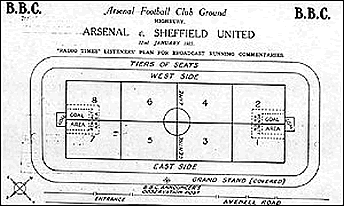‘Back to square one’ means back to the beginning; start again.
Back to square one
What's the meaning of the phrase 'Back to square one'?
What's the origin of the phrase 'Back to square one'?
‘Back to square one’ is a classic of folk etymology. Although the origin is uncertain, no uncertainty lurks in the minds of those who are sure how, where and when it was derived.
It ranks up there with ‘the whole nine yards‘ and ‘posh’ as an expression that people ‘know’ the origin of, when in fact they don’t.
There are three widely reported suggestions as to the phrase’s origin:
- BBC sports commentaries
- Board games like Snakes and Ladders
- Playground games like hopscotch
Let’s have a look at those ideas:
BBC Commentaries
Ask a group of people in the UK about the origin of ‘back to square one’ and it won’t be long before you are told that it originated with BBC football commentaries.
Early BBC radio commentaries did help listeners follow the progress of football and rugby games by notionally dividing the pitch into eight rectangles. Commentators described the play by saying which ‘square’ the ball was in. The Radio Times, the BBC’s listings guide, referred to the practice in an issue from January 1927.
Commentaries that used a numbering system certainly happened and prints of the pitch diagrams still exist.
Recordings of early commentaries also exist, including the very first broadcast sports commentary of any kind – a rugby match, as it happens.
That commentary, and many others that followed, referred listeners to the printed maps and a second commentator called out the numbers as the ball moved around the pitch. However, at no point in any existing commentary is the phrase ‘back to square one’ used.
Despite this, the BBC issued a piece in a January 2007 edition of The Radio Times celebrating 80 years of BBC football commentary in which the football commentator John Murray stated with confidence that:
“Radio Times’ grids gave us the phrase ‘back to square one’… the grid system was dropped in the 1930s – not before the phrase ‘back to square one’ had entered everyday vocabulary”.
Murray’s confidence belies the evidence. What counts against radio commentaries being the source of ‘back to square one’ is:
- The ‘squares’ are in fact rectangles. No commentary ever referred to them as squares.
- The position marked as Area One on the BBC grid is at one end of the pitch – which isn’t in any sense the beginning in a football game. For one team, Area One is near to their opponent’s goal. For the other team it near their own.
- Perhaps the most damning evidence is that the phrase isn’t known in print before 1952. That’s many years after the BBC abandoned the use of visual aids for radio sports commentaries.
Board Games
Other sources report that the phrase refers to Snakes and Ladders (Chutes and Ladders in the USA) or similar board games. The earliest citation of the phrase in print currently known is 1952, from the UK publication the Economic Journal:
“He has the problem of maintaining the interest of the reader who is always being sent back to square one in a sort of intellectual game of snakes and ladders.”
Another early use of ‘back to square one’, in the UK newspaper The Liverpool Echo, November 1959, also refers to Snakes and Ladders:
If the farmer wins, the line may have to be changed. In a game of snakes and ladders, the Ministry planners may find themselves back at square one.
Despite those citations, it isn’t a usual feature of Snakes and Ladders that players are sent back to square one. Of the many early examples of such boards that exist, only a few have a snake in the first square.
Hopscotch
This playground game is played on a grid of numbered squares. The precise rules of the game vary from place to place but it usually involves players hopping from square to square, missing out the square containing their thrown stone. They usually go from one to eight or ten and then back to square one.
The game’s name derives from ‘scotch’, which was used from the 17th century to denote a line scored on the ground and, of course, hopping. It was referred to in the 1677 edition of Robert Winstanley’s satirical almanac Poor Robin:
“The time when School-boys should play at Scotch-hoppers.”
Each of the above three explanations is plausible enough to gain supporters, although you would need to be somewhat perverse to believe the first.
As is usual with phrases of uncertain origin, most people are happy to believe the first explanation they hear. There’s not enough evidence to put the origin beyond reasonable doubt, and so it remains uncertain. However, the Snakes and Ladders derivation has the strongest claim.
Whatever the source, 1952 is surprisingly late as the earliest printing for the phrase. Perhaps a printed source from before 1952 will yield the truth?
See also: back to the drawing board.
BBC Commentaries
Ask a group of people in the UK about the origin of ‘back to square one’ and it won’t be long before you are told that it originated with BBC football commentaries.
Early BBC radio commentaries did help listeners follow the progress of football and rugby games by notionally dividing the pitch into eight rectangles. Commentators described the play by saying which ‘square’ the ball was in. The Radio Times, the BBC’s listings guide, referred to the practice in an issue from January 1927.
Commentaries that used a numbering system certainly happened and prints of the pitch diagrams still exist.
Recordings of early commentaries also exist, including the very first broadcast sports commentary of any kind – a rugby match, as it happens.
That commentary, and many others that followed, referred listeners to the printed maps and a second commentator called out the numbers as the ball moved around the pitch. However, at no point in any existing commentary is the phrase ‘back to square one’ used.
Despite this, the BBC issued a piece in a January 2007 edition of The Radio Times celebrating 80 years of BBC football commentary in which the football commentator John Murray stated with confidence that:
“Radio Times’ grids gave us the phrase ‘back to square one’… the grid system was dropped in the 1930s – not before the phrase ‘back to square one’ had entered everyday vocabulary”.
Murray’s confidence belies the evidence. What counts against radio commentaries being the source of ‘back to square one’ is:
- The ‘squares’ are in fact rectangles. No commentary ever referred to them as squares.
- The position marked as Area One on the BBC grid is at one end of the pitch – which isn’t in any sense the beginning in a football game. For one team, Area One is near to their opponent’s goal. For the other team it near their own.
- Perhaps the most damning evidence is that the phrase isn’t known in print before 1952. That’s many years after the BBC abandoned the use of visual aids for radio sports commentaries.
Board Games
Other sources report that the phrase refers to Snakes and Ladders (Chutes and Ladders in the USA) or similar board games. The earliest citation of the phrase in print currently known is 1952, from the UK publication the Economic Journal:
“He has the problem of maintaining the interest of the reader who is always being sent back to square one in a sort of intellectual game of snakes and ladders.”
Another early use of ‘back to square one’, in the UK newspaper The Liverpool Echo, November 1959, also refers to Snakes and Ladders:
If the farmer wins, the line may have to be changed. In a game of snakes and ladders, the Ministry planners may find themselves back at square one.
Despite those citations, it isn’t a usual feature of Snakes and Ladders that players are sent back to square one. Of the many early examples of such boards that exist, only a few have a snake in the first square.
Hopscotch
This playground game is played on a grid of numbered squares. The precise rules of the game vary from place to place but it usually involves players hopping from square to square, missing out the square containing their thrown stone. They usually go from one to eight or ten and then back to square one.
The game’s name derives from ‘scotch’, which was used from the 17th century to denote a line scored on the ground and, of course, hopping. It was referred to in the 1677 edition of Robert Winstanley’s satirical almanac Poor Robin:
“The time when School-boys should play at Scotch-hoppers.”
The history of “Back to square one” in printed materials
Trend of back to square one in printed material over time
Related articles
Related phrases and meanings
Browse more Phrases
About the Author

Phrases & Meanings
A-Z
A B C D E F G H I J K L M N O P Q R S T UV W XYZ
Categories
American Animals Australian Bible Body Colour Conflict Death Devil Dogs Emotions Euphemism Family Fashion Food French Horses ‘Jack’ Luck Money Military Music Names Nature Nautical Numbers Politics Religion Shakespeare Stupidity Entertainment Weather Women Work
How did we do?
Have you spotted something that needs updated on this page? We review all feedback we receive to ensure that we provide the most accurate and up to date information on phrases.
